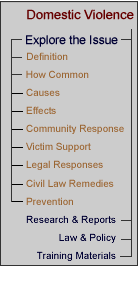|
|
|
POLICE A variety of strategies have been developed around the world with the goal of improving police response to domestic violence. Among the most important efforts at reform is the training of police in the dynamics of domestic violence and how best to protect victim safety and hold offenders accountable. In countries in the CEE/CIS region that have initiated police training programs, some advocates are reporting positive outcomes. For example, in Slovenia, advocates wrote, that “[t]he police force is one of the institutions that has contributed significantly to changing attitudes towards domestic violence in recent years. The police are well trained . . . In general, police awareness of domestic violence has increased enormously which is partly a result of good relationships with women’s NGO’s.” From International Helsinki Federation for Human Rights, Women 2000: An Investigation into the Status of Women’s Rights in Central and South-Eastern Europe and the Newly Independent States 421 (2000). Another strategy aimed at improving the police response to domestic violence is the promotion of pro-arrest or mandatory arrest polices. In cases involving simple or minor injuries, “probable cause” arrest policies allow police officers to make arrests based on the presence of evidence (such as damaged property, visible injuries, or a frightened woman) that would lead to the conclusion that an assault occurred. Police may make the arrest without witnessing the crime. Mandatory arrest policies take this one step further and require the police to make an arrest at the scene of a domestic assault. These policies are reinforced by research that indicates arrest is an effective method of reducing domestic violence. They are also seen by many as necessary to combat a long-standing and globally prevalent police attitude that domestic violence is not a crime. Many agree that the most effective response to domestic violence occurs when arrest is combined with a coordinated community response, in which key players such as the criminal justice system, shelters, medical service providers, housing agencies are knowledgeable and communicating with each other about domestic violence. Pro and mandatory arrest policies can, however, be problematic in countries with a history of government oppression. As a women’s advocate from Bolivia explained, “[i]n times when the state and its instruments have penetrated the bedroom only to repress and pillage, such as during the dictatorships which coerced the law to legitimize their authoritarian regimes, it is quite difficult to publicly debate the problem of domestic violence without appearing to endorse the misuse of power.” From Sonia Montana, Long Live the Differences, with Equal Rights: A Campaign to End Violence Against Women in Bolivia, in Freedom From Violence: Women’s Strategies From Around the World 213, 225 (Margaret Schuler ed., 1992). Similarly, in the CEE/CIS region, mistrust of police and police corruption may be an obstacle the effectiveness of pro and mandatory arrest policies. In India and Brazil, NGOs have provided the impetuous for the creation of women’s police stations. Although such stations help to increase awareness of the issue and to change attitudes that condone domestic violence, the success of such stations in increasing victim protection or the conviction rates of batterers is unclear. The NGO, Promoting Women in Development, notes that women’s police stations in India were unable to address the issue of domestic violence effectively
Isolated changes within the system are unlikely to succeed unless these changes are coordinated with other responses, such as the allocation of resources to various departments. In addition, such stations, like specialized courts, are faced with the danger that they will be marginalized as stations that deal with “family,” as opposed to “real,” crimes. From Promoting Women in Development, Justice, Change, and Human Rights: International Research and Responses to Domestic Violence 16 (2000); Cheryl Thomas, Domestic Violence, in 1 Women and International Human Rights Law 219, 233 (Kelly D. Askin & Dorean M. Koenig eds., 1999). In the United States, advocates brought legal action against the police for failure to protect women from domestic violence by not responding to victims’ calls to police and not enforcing criminal assault laws in cases of domestic violence. The first class action lawsuit, Scott v. Hart, No. C-76-2395 (N.D. Cal. Filed Oct. 28, 1976), was filed against the Oakland, California city police in 1976. Two months later, in Bruno v. Codd, 396 N.Y.S.2d 974 (Sup. Ct. Special Term 1977), rev’d in part, appeal dismissed in part, 407 N.Y.S.2d 165 (1978), aff’d, 47 N.Y.2d 582 (1979), activists filed suit against the New York City Police for failure to comply with state laws. Bruno v. Codd, for example, was a suit brought by an NGO on behalf of twelve women who had received no assistance from the police after they were attacked by their intimate partners. One of those women stated that the police did not arrest her husband even after they watched him attempt to strangle her. The lawsuits were settled when both police departments agreed to change their practices in domestic violence cases. From R. Emerson Dobash & Russel P. Dobash, Women, Violence and Social Change 121 (1992); Cheryl Thomas, Domestic Violence, in 1 Women and International Human Rights Law 219, 234 & n.69 (Kelly D. Askin & Dorean M. Koenig eds., 1999). Though the lawsuits in the United States were not based on international human rights law, police failure to enforce laws to protect victims of domestic violence is clearly a human rights violation. Police, as agents of the state, have an obligation under human rights law to apply the laws without discriminating against women and to protect a woman’s right to be free from violence. From Kenneth Roth, Domestic Violence as an International Human Rights Issue, in Human Rights of Women: National and International Perspectives 326 (1994); Dorothy Q. Thomas & Michele E. Beasley, Domestic Violence as a Human Rights Issue, 15 H.R.Q. 36 (1993). |

